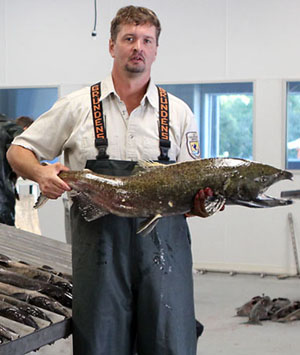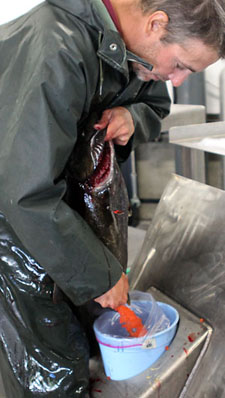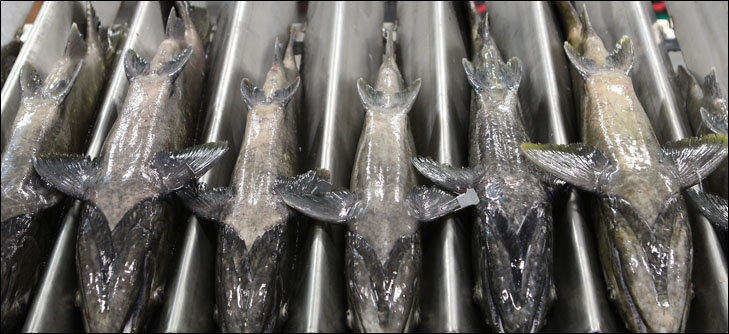| |
 Matt Hall, a biologist from the U.S. Department of Fish and Wildlife's Wenatchee office holds a 15 pound spring Chinook that would have weighed about 25 pounds as it began to muscle its way up the Columbia River towards its Methow spawning.
600,000 Salmon
New hatchery spawning facility
story and photos by Solveig Torvik
Some 220 spring Chinook salmon pairs spawned this month with a little help from their friends at the U.S. Fish and Wildlife Service hatchery in Winthrop. The next opportunity for the public to watch hand-spawning of salmon from the viewing room in the hatchery’s new spawning facility won’t be until Coho are processed in late October, said hatchery manger Chris Pasley.
The 855,000 eggs taken during the spawning project that ended Aug. 29 will be kept in chilled water in incubator trays until March, said Pasley. They’ll be moved into rearing tanks about the same time that their wild-spawned cousins emerge from their gravel nests in rivers. Chilling the water means the eggs won’t develop too fast. Before fish scientists learned to put the eggs into chilled water, they would become ready to move along into the rearing tanks as early as December, which was too soon. It was stressful for them as well as more work for the fish biologists, said Pasley.
The eggs are expected to produce 600,000 smolts, 400,000 of which will be released when they’re 18 months old directly from the Winthrop hatchery tanks right into the Methow River, he said. If all goes as planned, the other 200,000 will go to the Confederated Tribes of the Colville Reservation for planting in the Okanogan River.
 Bob Gerwig removes salmon eggs from a female spring Chinook. They’ll be back in 2016, providing they survive the perilous journey out to sea, unpredictable ocean conditions and the daunting journey home past nine dams on the Columbia River. A few will come back as three-year old males, so-called “Jacks.” As many as 20 percent of them may wait five years to come back. That’s Mother Nature’s biological insurance policy. Should something calamitous wipe out the bulk of the fourth-year returnees, there still would be a remnant population.
The hatchery has never had more than a .03 to 1 percent return rate, Pasley said. “I think it’s pretty comparable to most other spring Chinook runs on the Columbia,” he added, especially given the extra number of dams these fish in the Upper Columbia basin have to traverse. It costs about 60 cents to raise each fish, he added.
About 2,000 spring Chinook made it home in the run that was spawned in August, he said. Fish not used in that spawning program were given to nearby Indian tribes earlier this spring; the carcasses of spawned fish are inedible, so they are buried.
The worst year for returns at the hatchery was in 1995, when only 14 of the 950,000 released spring Chinook returned, Pasley said. Since then, biologists have learned a great deal more about how to raise the fish, according to Pasley. Water quality and nutrition have improved and the hatchery is raising better fish.
“Every little thing helps. We raise a lot healthier fish now that we did in the ‘90s.” The goal is to eventually have a spring Chinook sports fishery in the Methow River, said Pasley “We’re getting pretty consistent returns now.”

These spring Chinook were first put to sleep by being immersed in a tank of CO2, then were killed one at a time by a pneumatic hammer. After the sperm was removed from the males and the eggs from females, samples, including kidneys, were taken to check fish health. Finally they were checked for identifying pit tags in their stomachs and wires in their snouts to assure that only local brood stock is propagated; any eggs from other stocks that show up in the run are given to the state's hatchery program. Finally the spawned-out salmon are discarded to be buried. Many fish from this run that were not needed by the hatchery earlier were given to nearby Indian tribes. The meat of the fish being discarded after spawning is not fit to eat, according to hatchery officials.
9/5/2012
|
|
